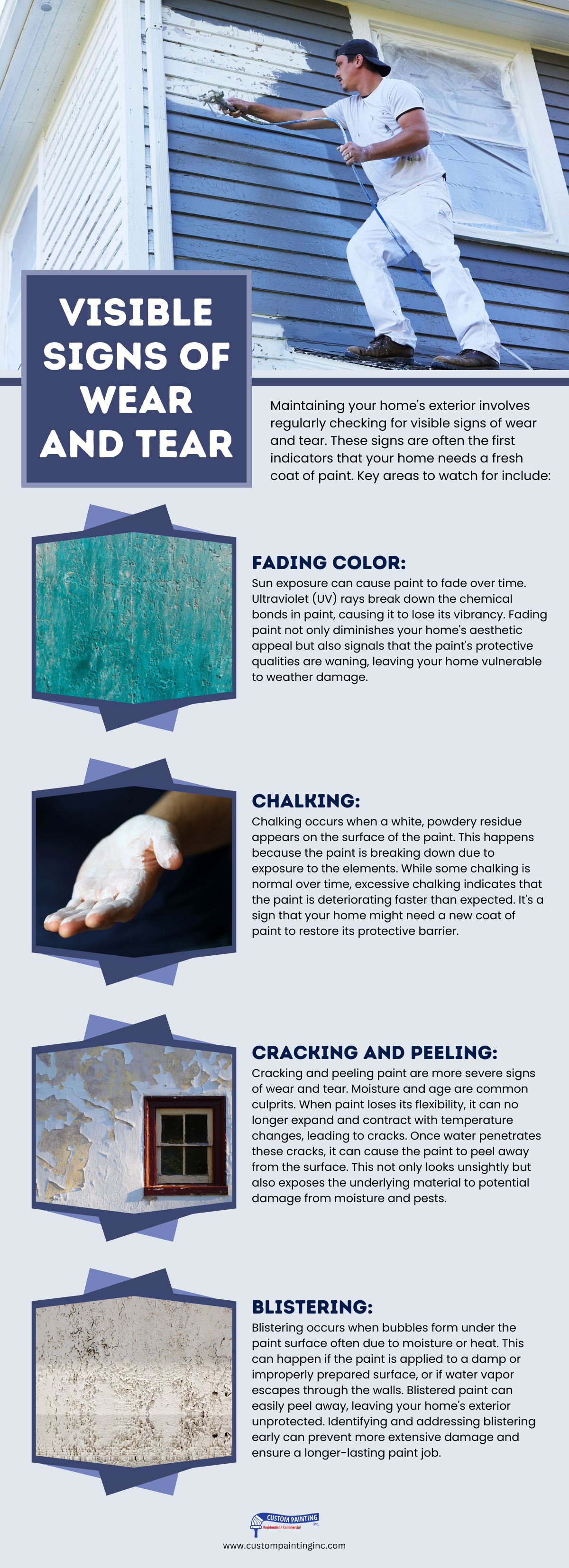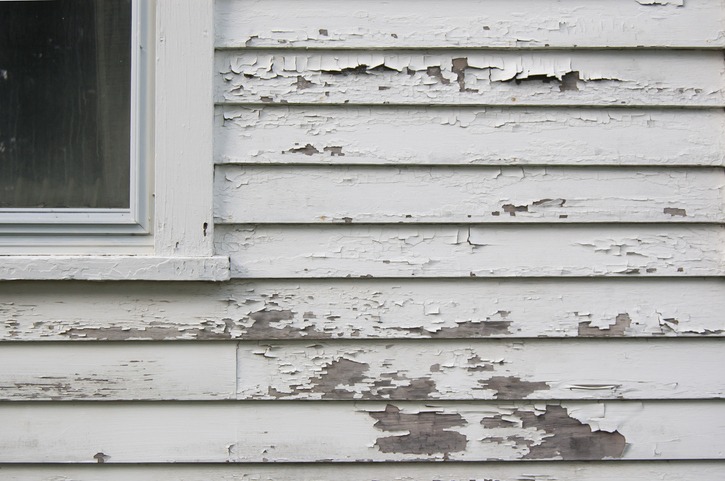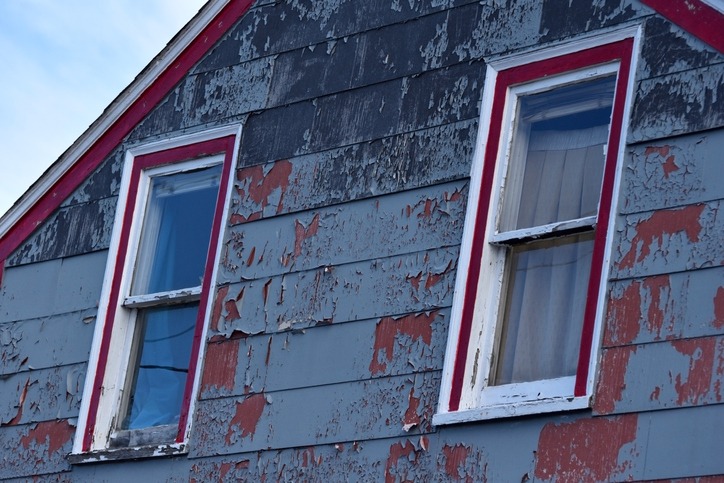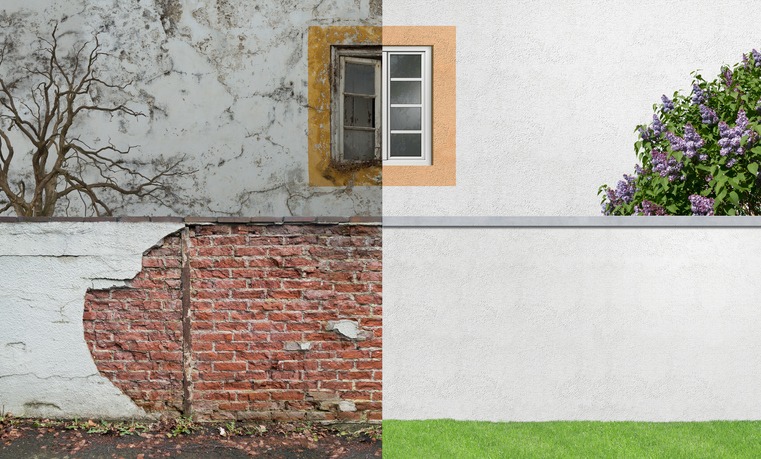Maintaining your home’s exterior is essential for both curb appeal and long-term protection against the elements. Over time, weather and wear can take a toll on your house’s appearance, leading to potential damage and a decrease in property value. Recognizing when it’s time to repaint can save you money and headaches down the road.
This article will guide you through the key signs that indicate it’s time to give your home’s exterior a fresh coat of paint. By identifying these signs early, you can ensure your home remains attractive and well-protected against the elements.
Visible Signs of Wear and Tear

Maintaining your home’s exterior involves regularly checking for visible signs of wear and tear. These signs are often the first indicators that your home needs a fresh coat of paint. Key areas to watch for include:
- Fading Color: Sun exposure can cause paint to fade over time. Ultraviolet (UV) rays break down the chemical bonds in paint, causing it to lose its vibrancy. Fading paint not only diminishes your home’s aesthetic appeal but also signals that the paint’s protective qualities are waning, leaving your home vulnerable to weather damage.
- Chalking: Chalking occurs when a white, powdery residue appears on the surface of the paint. This happens because the paint is breaking down due to exposure to the elements. While some chalking is normal over time, excessive chalking indicates that the paint is deteriorating faster than expected. It’s a sign that your home might need a new coat of paint to restore its protective barrier.
- Cracking and Peeling: Cracking and peeling paint are more severe signs of wear and tear. Moisture and age are common culprits. When paint loses its flexibility, it can no longer expand and contract with temperature changes, leading to cracks. Once water penetrates these cracks, it can cause the paint to peel away from the surface. This not only looks unsightly but also exposes the underlying material to potential damage from moisture and pests.
- Blistering: Blistering occurs when bubbles form under the paint surface often due to moisture or heat. This can happen if the paint is applied to a damp or improperly prepared surface, or if water vapor escapes through the walls. Blistered paint can easily peel away, leaving your home’s exterior unprotected. Identifying and addressing blistering early can prevent more extensive damage and ensure a longer-lasting paint job.
Regularly inspecting your home’s exterior for these signs can help you maintain its appearance and structural integrity. Addressing wear and tear promptly with a fresh coat of paint will keep your home looking its best and protected from the elements.
Structural Issues
Structural issues are serious concerns that go beyond cosmetic damage to your home’s exterior. These issues can compromise the integrity of your house and lead to expensive repairs if not addressed promptly. Key areas to monitor include wood rot, mold and mildew, and weather-related damage.
Wood Rot
Wood rot is a common problem, especially in homes with wooden exteriors. It occurs when moisture penetrates the wood, leading to fungal growth that decays the material. Signs of wood rot include:
- Soft, spongy wood
- Discoloration (often dark or light patches)
- A musty smell
- Crumbling wood
Wood rot weakens the structure of your home, compromising its stability and safety. If left untreated, it can spread and cause significant damage, requiring costly repairs.
Mold and Mildew
Mold and mildew are fungi that thrive in damp environments. They can grow on painted surfaces, especially in areas with poor ventilation or frequent exposure to moisture. Signs of mold and mildew include:
- Black, green, or white patches on surfaces
- A musty odor
- Discoloration and staining
Mold and mildew not only mar the appearance of your home but also pose health risks, including respiratory issues and allergies. Addressing mold and mildew promptly is crucial to maintaining a healthy living environment and protecting the integrity of your home’s exterior.
Weather-Related Damage
Water stains and leaks are common signs of water damage. They often appear as:
- Dark streaks or patches on walls and ceilings
- Bubbling or peeling paint
- Damp or musty smells
These issues can result from faulty gutters, roof leaks, or poor sealing around windows and doors. Water damage can lead to mold growth and structural deterioration if not addressed quickly.
Extreme Weather Effects
Severe weather conditions, such as heavy rain, snow, hail, and extreme temperatures, can significantly impact your home’s exterior. Effects include:
- Heavy Rain and Snow: Prolonged exposure to moisture can cause paint to wear away, leading to water infiltration and damage to underlying materials.
- Hail: Hailstones can chip and crack paint, exposing the surface beneath to further damage.
- Extreme Temperatures: Frequent freezing and thawing can cause paint to expand and contract, leading to cracks and peeling. High temperatures can cause paint to blister and fade.
Regular maintenance and timely repainting can help protect your home from the damaging effects of weather and keep it looking its best. By addressing these structural issues promptly, you can ensure your home’s longevity and preserve its value.
Maintenance and Aesthetic Reasons
Beyond protecting your home from the elements and structural issues, there are also important maintenance and aesthetic reasons to consider repainting your home’s exterior. Keeping your home looking fresh and modern can enhance its appearance and increase its market value.
Outdated Colors
Exterior paint colors can quickly become outdated as design trends evolve and personal tastes change. A color that was popular a decade ago might now make your home look dated. Repainting with a more contemporary color scheme can:
- Reflect your current style and preferences
- Make your home stand out in your neighborhood
- Give your home a fresh, modern look
Choosing colors that are currently in vogue can significantly boost your home’s visual appeal, making it more attractive to visitors and potential buyers.
Home Value
A fresh coat of paint does more than just improve your home’s appearance; it can also enhance its market value. A well-maintained exterior signals to potential buyers that the home has been cared for, which can:
- Increase curb appeal, making a strong first impression
- Raise the perceived value of the property
- Potentially lead to a higher selling price
Real estate experts often recommend repainting as a cost-effective way to boost your home’s value before listing it for sale. Even if you’re not planning to sell, maintaining a freshly painted exterior can provide pride in ownership and make your home a more pleasant place to live.
By keeping your home’s exterior up to date with current trends and ensuring it looks well-maintained, you can enjoy the benefits of increased curb appeal and higher property value. Regular repainting as part of your home’s maintenance routine is a wise investment in both its aesthetic and financial future.
Benefits of Painting Your Home’s Exterior
Repainting your home’s exterior offers numerous benefits that extend beyond aesthetic appeal. It plays a crucial role in maintaining and enhancing your property, contributing to its longevity, value, and overall enjoyment.
Protection from the Elements
A fresh coat of paint serves as a protective barrier against the elements. It shields your home from:
- Moisture: Prevents water from seeping into wood and other materials, reducing the risk of rot and mold.
- UV Rays: Protects against sun damage, which can cause fading, chalking, and degradation of materials.
- Weather: Defends against harsh weather conditions such as rain, snow, and wind, which can wear down your home’s exterior over time.
Enhanced Curb Appeal
One of the most immediate and noticeable benefits of painting your home’s exterior is improved curb appeal. A well-painted home looks fresh, clean, and inviting. This can:
- Create a Positive First Impression: Whether for guests or potential buyers, a well-maintained exterior makes a strong, positive statement.
- Stand Out in the Neighborhood: A freshly painted home can enhance the overall appearance of your neighborhood, adding to the community’s appeal.
Increased Property Value
A fresh coat of paint can significantly boost your home’s market value. Key advantages include:
- Higher Perceived Value: A well-painted home appears more attractive and well-cared-for, which can lead to a higher selling price.
- Faster Sales: Homes with excellent curb appeal often sell more quickly than those in need of visible maintenance.
Improved Lifespan of Exterior Surfaces
Regular painting helps extend the life of your home’s exterior surfaces. Benefits include:
- Prevention of Deterioration: By sealing and protecting surfaces, paint helps prevent deterioration from moisture, pests, and environmental factors.
- Early Detection of Issues: The process of preparing your home for painting often reveals minor issues that can be addressed before they become major problems.
Personal Satisfaction and Enjoyment
Repainting your home can also provide personal satisfaction and enjoyment. It allows you to:
- Express Personal Style: Choose colors and finishes that reflect your tastes and preferences, making your home feel truly yours.
- Enhance Pride of Ownership: A freshly painted home can give you a sense of pride and accomplishment, making your living environment more enjoyable.
By investing in a fresh coat of paint, you can protect your home, boost its value, and enhance its beauty, ensuring that it remains a source of pride and satisfaction for years to come.
When to Consult a Professional?
While some homeowners may feel confident tackling exterior painting projects on their own, there are several situations where consulting a professional is the best course of action. Professional painters bring expertise, experience, and the right tools to ensure a high-quality, long-lasting paint job.
Extensive Damage or Repairs
If your home’s exterior has extensive damage or requires significant repairs, it’s wise to call in a professional. Issues such as:
- Severe Wood Rot: Professional painters can assess the extent of the damage and recommend appropriate repairs before painting.
- Widespread Mold and Mildew: Experts can safely remove mold and mildew and treat surfaces to prevent recurrence.
- Structural Damage: Professionals can identify underlying issues that need to be addressed to prevent further deterioration.
Complex Surfaces or Heights
Homes with complex architectural details or multiple stories can be challenging to paint. Professionals have the equipment and skills to handle:
- High or Hard-to-Reach Areas: Ladders, scaffolding, and safety gear allow professionals to work safely and efficiently.
- Detailed Trim and Features: Intricate trim, shutters, and other features require a steady hand and attention to detail.
- Diverse Materials: Different surfaces (wood, brick, stucco) may require specific preparation and paint types.
Time and Quality Considerations
Painting a home’s exterior is time-consuming and labor-intensive. Hiring professionals can save you time and ensure a high-quality finish. Benefits include:
- Efficiency: Professional painters can complete the job faster than most DIY efforts.
- Quality Materials: Professionals use high-quality paints and materials that offer better durability and protection.
- Expert Application: A professional’s expertise ensures even coverage, proper adhesion, and a smooth finish.
Long-Term Savings
While hiring a professional may seem like a larger upfront investment, it can save you money in the long run. Professionals ensure the job is done right the first time, reducing the likelihood of premature wear and the need for frequent repainting.
Consulting a professional for your exterior painting needs can provide peace of mind, knowing that your home will be well-protected and visually appealing for years to come. Whether dealing with extensive damage, complex surfaces, or simply wanting the best possible results, professional painters are equipped to handle the job with expertise and efficiency.
Regular Maintenance Tips
Maintaining your home’s exterior paint job is essential to preserving its appearance and protecting it from the elements. Regular maintenance can extend the life of your paint and prevent costly repairs. Here are some key tips to keep your home’s exterior looking its best.
Routine Inspections
Performing routine inspections helps you identify potential problems early. Regularly check for:
- Peeling or Cracking: Look for areas where the paint is starting to peel or crack, which can expose the underlying material to damage.
- Fading or Chalking: Check for signs of fading or chalking paint, which indicate that the paint is losing its protective qualities.
- Moisture Damage: Inspect for any signs of moisture damage, such as water stains or mold growth.
Cleaning the Exterior
Keeping your home’s exterior clean can prevent the buildup of dirt, mold, and mildew, which can degrade the paint over time. Follow these cleaning tips:
- Wash Annually: Use a garden hose or pressure washer to wash the exterior at least once a year. Be gentle to avoid damaging the paint.
- Remove Mold and Mildew: Use a mixture of water and bleach to clean areas affected by mold and mildew. Scrub gently with a soft brush.
Touch-Up Paint
Addressing small areas of wear and tear promptly can prevent them from becoming larger issues. Tips for touch-up painting include:
- Match the Paint: Keep some extra paint from your last painting project to ensure you have an exact match for touch-ups.
- Prepare the Surface: Clean and sand the area before applying the touch-up paint to ensure good adhesion.
- Apply Evenly: Use a small brush to apply the paint evenly, blending it with the surrounding area.
Seal Gaps and Cracks
Sealing gaps and cracks can prevent moisture from entering and causing damage. Regularly inspect and:
- Caulk Gaps: Check around windows, doors, and trim for gaps or cracks. Apply a high-quality exterior caulk to seal these areas.
- Repair Damage: Fill in any cracks or holes in the siding with appropriate filler materials, then repaint to protect the surface.
Protect Against the Elements
Taking additional steps to protect your home from the elements can further extend the life of your paint job. Consider:
- Installing Gutters and Downspouts: Properly functioning gutters and downspouts direct water away from your home’s exterior, reducing the risk of water damage.
- Trimming Vegetation: Keep trees, bushes, and other vegetation trimmed back from your home’s exterior to prevent damage from branches and to allow for proper air circulation.
By following these regular maintenance tips, you can keep your home’s exterior paint looking fresh and vibrant, ensuring long-lasting protection and curb appeal. Regular care and attention will help you avoid larger, more costly repairs in the future, maintaining the beauty and value of your home.
Conclusion
If you’ve noticed any of the signs discussed in this article, it’s time to take action. Addressing these issues promptly will help maintain your home’s beauty and structural integrity. Keeping your home’s exterior in good condition not only enhances its appearance but also protects your investment, increases property value, and ensures a safe and healthy living environment.
Don’t wait for small issues to become costly problems. Repainting your home’s exterior can provide lasting benefits and peace of mind. For professional, high-quality painting services, contact Custom Painting, Inc. at 925-294-8062 or reach out through our contact form. Our team of experts is ready to help you keep your home looking its best.





